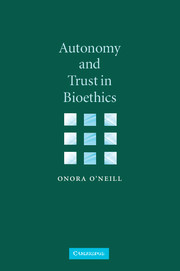Book contents
- Frontmatter
- Contents
- Preface
- Frontispiece
- 1 Gaining autonomy and losing trust?
- 2 Autonomy, individuality and consent
- 3 ‘Reproductive autonomy’ and new technologies
- 4 Principled autonomy
- 5 Principled autonomy and genetic technologies
- 6 The quest for trustworthiness
- 7 Trust and the limits of consent
- 8 Trust and communication: the media and bioethics
- Bibliography
- Institutional bibliography
- Index
8 - Trust and communication: the media and bioethics
Published online by Cambridge University Press: 06 November 2009
- Frontmatter
- Contents
- Preface
- Frontispiece
- 1 Gaining autonomy and losing trust?
- 2 Autonomy, individuality and consent
- 3 ‘Reproductive autonomy’ and new technologies
- 4 Principled autonomy
- 5 Principled autonomy and genetic technologies
- 6 The quest for trustworthiness
- 7 Trust and the limits of consent
- 8 Trust and communication: the media and bioethics
- Bibliography
- Institutional bibliography
- Index
Summary
TRUSTWORTHINESS WITHOUT TRUST?
In chapters 6 and 7 I have looked at problems that arise when trustworthiness and trust pull apart, and at some ways in which these problems might be reduced. Being trustworthy helps in gaining trust, but is neither necessary nor sufficient. Deceivers can attract others' trust, so misplaced trust is common enough. The trustworthy can be denied others' trust, so misplaced mistrust is also common enough. Improving trustworthiness can reduce the incidence of misplaced trust; but may not attract reciprocating trust, so cannot eliminate misplaced mistrust. The ‘Cassandra problem’ is recalcitrant.
The problem of misplaced mistrust can, I have suggested, be resolved to a degree when trust is sought from identifiable individuals. Action can be made contingent on their consent, and forgone when they withhold consent. Consent procedures that seek genuine communication rather than legalistic form-filling, and that make it abundantly clear that dissent constitutes a veto on others' proposals for action, can help build trust. They can help to secure and maintain patients' trust in their doctors, research subjects' trust in investigators and more generally individuals' trust in others.
But this approach to restoring trust fails where action and policy bear not on identifiable individuals, but on groups or populations who are put at indeterminate risk. Only where the risks arising from some policy are unambiguously higher than available alternatives, and those arising from alternatives unambiguously less, can we regard persisting with the policy as tantamount to injuring or endangering others.
- Type
- Chapter
- Information
- Autonomy and Trust in Bioethics , pp. 165 - 192Publisher: Cambridge University PressPrint publication year: 2002



